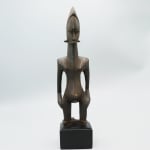Senufo Figure (Cote d'Ivoire), Nineteenth Century AD
Wood
25.4 x 7.3 x 6.5 cm
10 x 2 7/8 x 2 1/2 in
10 x 2 7/8 x 2 1/2 in
LI.3301
Further images
-
(View a larger image of thumbnail 1
)

-
(View a larger image of thumbnail 2
)

-
(View a larger image of thumbnail 3
)

-
(View a larger image of thumbnail 4
)

-
(View a larger image of thumbnail 5
)

-
(View a larger image of thumbnail 6
)

-
(View a larger image of thumbnail 7
)

-
(View a larger image of thumbnail 8
)

-
(View a larger image of thumbnail 9
)

‘Senufo’ is a nebulous designation, referring to a diverse assortment of subgroups who live in a fairly broad region encompassing the Côte d’Ivoire, southeastern Mali, western Burkina Faso, and parts...
‘Senufo’ is a nebulous designation, referring to a diverse assortment of subgroups who live in a fairly broad region encompassing the Côte d’Ivoire, southeastern Mali, western Burkina Faso, and parts of northern Ghana. These groups are linked by a roughly similar language – though the diverse dialects are so varied that they are often not mutually intelligible – and through similar artistic output. But the main unifying feature of the Senufo is the existence of two institutions: the poro and the sandogo. These two secret societies were important in the life of the Senufo, as the mechanism through which men (poro) and women (sendogo) came of age. A predominantly agricultural people, the Senufo emphasised the combination of the male and female in regenerating life. As a result, the mixing of the two societies once the members came of age was one of the central moments of Senufo life.
On altars relating to poro, male and female figures stand shoulder to shoulder. The male figure usually holds some kind of agricultural implement, usually a sickle, while the female is depicted displaying exaggerated feminine attributes – prominent breasts, wide hips, round buttocks – to emphasise her role in bringing fertility to the fields. The female figure is often taller than the male, and emphasises the importance of females as the matrilineal founders of the Senufo people. For the Senufo, the female was the original ancestor, predating the male in the origin myth. This exceptional Senufo sculpture exudes femininity at the same time as expressing the ability of the artist to abstract and elongate the human form. It depicts a woman with emphasised feminine attributes, standing in a powerful position with her knees bent and her arms by her sides, hands on her hips. Her face is an elongated ovoid, with a stretched forehead and with small features. Her bottom lip protrudes, her nose is slender and straight, and she has almond-shaped heavily lidded eyes. She has a traditional Senufo hairstyle that rises helmet-like from her head. The poro had two kinds of altar-figures: the taller pombibele, which were brought out during funerals, and swung around, hitting the ground as a percussive instrument; and the smaller ndebele. Pombibele could be as tall as one metre (e.g. Indianapolis Museum of Art 1999.31). This figure is an ndebele, and would have sat on the altar of an important leading member of the poro society.
The artistic output of the Senufo is among the most aesthetically arresting in all African art, and has had a significant impact on Western art and art history. The first exhibition of African art in New York, for example, at the now-defunct Museum of Primitive Art, was 1963’s Senufo Sculpture from West Africa (curator: Robert Goldwater). The elongated forms of Senufo art have influenced artists as diverse as Picasso and Henry Moore.
On altars relating to poro, male and female figures stand shoulder to shoulder. The male figure usually holds some kind of agricultural implement, usually a sickle, while the female is depicted displaying exaggerated feminine attributes – prominent breasts, wide hips, round buttocks – to emphasise her role in bringing fertility to the fields. The female figure is often taller than the male, and emphasises the importance of females as the matrilineal founders of the Senufo people. For the Senufo, the female was the original ancestor, predating the male in the origin myth. This exceptional Senufo sculpture exudes femininity at the same time as expressing the ability of the artist to abstract and elongate the human form. It depicts a woman with emphasised feminine attributes, standing in a powerful position with her knees bent and her arms by her sides, hands on her hips. Her face is an elongated ovoid, with a stretched forehead and with small features. Her bottom lip protrudes, her nose is slender and straight, and she has almond-shaped heavily lidded eyes. She has a traditional Senufo hairstyle that rises helmet-like from her head. The poro had two kinds of altar-figures: the taller pombibele, which were brought out during funerals, and swung around, hitting the ground as a percussive instrument; and the smaller ndebele. Pombibele could be as tall as one metre (e.g. Indianapolis Museum of Art 1999.31). This figure is an ndebele, and would have sat on the altar of an important leading member of the poro society.
The artistic output of the Senufo is among the most aesthetically arresting in all African art, and has had a significant impact on Western art and art history. The first exhibition of African art in New York, for example, at the now-defunct Museum of Primitive Art, was 1963’s Senufo Sculpture from West Africa (curator: Robert Goldwater). The elongated forms of Senufo art have influenced artists as diverse as Picasso and Henry Moore.








